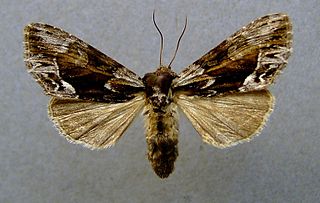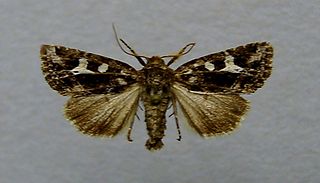
The autumnal rustic is a moth of the family Noctuidae. The species was first described by Eugenius Johann Christoph Esper in 1788. It was previously placed in the genus Paradiarsia. It is found in northern and western Europe and North Africa.

The true lover's knot is a moth of the family Noctuidae. The species was first described by Michael Denis and Ignaz Schiffermüller in 1775. It is found in the west Palearctic in a wide band through northern, central and eastern Europe and Russia. In the south it is spread through northern Spain and northern Portugal, northern Italy, Macedonia, Bulgaria, and northern Greece. In Europe it is found wherever its food plants grow. It is traditionally thought of as a species typical of heathland and moorland but it can often be found in places where heather and its relatives are in garden cultivation. In the mountains it is found up to an elevation of over 2000 metres above sea level.

The angle shades is a moth of the family Noctuidae. The species was first described by Carl Linnaeus in his 1758 10th edition of Systema Naturae. It is distributed throughout Europe as far east as the Urals and also in the Azores, in Algeria, and in Asia Minor, Armenia, and Syria. It is strongly migratory.

The straw underwing is a species of moth in the family Noctuidae. The species was first described by Johann Siegfried Hufnagel in 1766. It is found from North Africa west through South Europe and Central Europe. In the north it is in parts of Ireland, Scotland, Sweden, Norway, Finland and Estonia. Further east the range stretches from southern Russia and Asia minor to the Caucasus.

Orthosia incerta, the clouded drab, is a species of moth of the family Noctuidae, found in Europe and Asia. The occurrence of the species extends through all European countries through the Palearctic to the Russian Far East and Japan. It is absent from northern Fennoscandia and in the Alps it occurs up to 2000 m above sea level.

Orthosia cruda, the small Quaker, is a moth of the family Noctuidae. It is found in Europe, Morocco, Algeria, Tunisia, Turkey, the Caucasus, Transcaucasia, Kazakhstan, Israel, Lebanon, Cyprus and Jordan.

Hydraecia micacea, the rosy rustic, is a moth of the family Noctuoidea. It is found across the Palearctic realm from Ireland to Siberia. It reaches Japan and is introduced to eastern USA, Quebec and Ottawa.

Colocasia coryli is a moth of the family Noctuidae. It is found in Europe and Asia. In the north of its range, the distribution area includes northern Scandinavia, while in the south the moth is limited to montane areas of western and northern Spain, Sicily, Greece, Romania and Asia minor. To the east, the range extends across the Palearctic to Lake Baikal. In the Alps it is found at elevations up to 1600 m.

Helotropha leucostigma, the crescent, formerly Celaena leucostigma is a moth of the family Noctuidae. It is found in the Palearctic realm.

Mythimna straminea, the southern wainscot, is a moth of the family Noctuidae. The species was first described by Georg Friedrich Treitschke in 1825. It is found in the western parts of the Palearctic realm, including Morocco, Europe, Turkey, the Caucasus, Israel, and Lebanon.

Mythimna obsoleta, the obscure wainscot, is a moth of the family Noctuidae. The species was first described by Jacob Hübner in 1803. It is found in Europe, from southern Fennoscandia to Spain, Italy and the Balkans, the European part of Russia, the Caucasus, Kazakhstan, Kyrgyzia, southern Siberia, Turkey, the Ural, Mongolia, the Russian Far East, the Korean Peninsula, China and Hokkaido and Honshu in Japan.

Chortodes fluxa, the mere wainscot, is a moth of the family Noctuidae. The species was first described by Jacob Hübner in 1809. It is found in Europe and east across the Palearctic to Siberia, Mongolia, and northern China. Also in northern Turkey and the Caucasus.

Mesapamea secalis, the common rustic, is a moth of the family Noctuidae. The species was first described by Carl Linnaeus in his 1758 10th edition of Systema Naturae. It is found in Europe, north-west Africa, Turkey and northern Iran.

Agrotis trux, the crescent dart, is a moth of the family Noctuidae. The species was first described by Jacob Hübner in 1824. It has a circum-Mediterranean distribution and is found along the coasts of France, Ireland, England, southern Europe, Algeria, Syria, Iraq, Iran, southern Russia and the Arabian Peninsula. In Africa, it is found as far south as South Africa.

Hyppa rectilinea, the Saxon, is a moth of the family Noctuidae. It is found in Europe, but mostly in northern and central Europe. In the south, it is found in scattered populations, mainly in mountainous areas. To the east, its range stretches through northern Asia and eastern Siberia, up to the Pacific Ocean and Japan.

Actinotia polyodon, the purple cloud, is a moth of the family Noctuidae. It is found in much of the Palearctic realm, from Europe to Russia and Japan.

Celaena haworthii, or Haworth's minor, is a moth of the family Noctuidae. The species was first described by John Curtis in 1829. It is found from the British Isles and France through northern Europe including Scandinavia, east to the Urals and across the Palearctic to Siberia and up to the Pacific Ocean.

Archanara dissoluta, the brown-veined wainscot, is a moth of the family Noctuidae. The species was first described by Georg Friedrich Treitschke in 1825. It is found in most of Europe, east into Russia and Siberia.

Chloantha hyperici, the pale-shouldered cloud, is a moth of the family Noctuidae. It is found in southern Central Europe and from southern Europe to the Near East and Anatolia, Israel, Iraq, the Persian Gulf and the Caucasus, as well as northern Denmark, southern Sweden, southern Norway and south-western Finland.

Mniotype adusta, the dark brocade, is a moth of the family Noctuidae. It was described by Eugenius Johann Christoph Esper in 1790. It is found throughout much of the Palearctic from Europe to Japan, China and Mongolia. It is also found in North America. The habitat consists of heathland, chalky downland, fenland, moorland and upland areas.





















